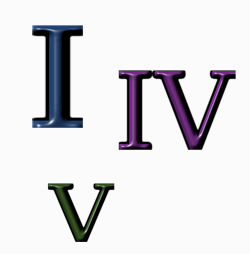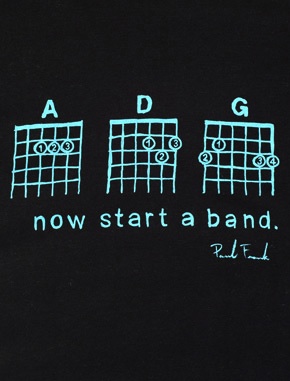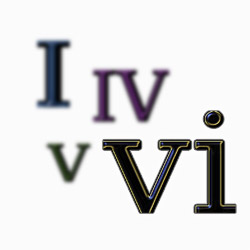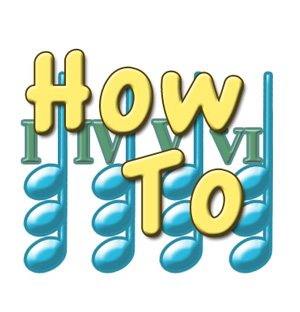Learning to play chords by ear and improvise freely over chords are essential ear training goals for many musicians. Chord ear training is a big topic but can be broken into two main skills: recognising chord types and identifying chord progressions. In this article we’ll explore chord progressions ear training in depth.
Chord progression ear training helps you to:
- Play songs by ear.
Knowing the key and identifying the progression by ear tells you exactly which chords to play. - Improvise solos.
For musical impact, your solo should match the underlying chord progression. - Write better songs.
If you compose or write songs, chord progressions ear training will build your understanding of harmonies you can use. - Memorise songs easily.
Progressions ear training lets you hear the underlying patterns rather than just arbitrary sequences of chords to remember.
Before you start progressions ear training though, you should first know your basic chord types. Spend time on chord types ear training so that you’re really solid on major versus minor. You should ideally study some further types of chord too, such as the other two triad chords, or chords which are relevant for your instrument or genre. For example, if you want to play blues progressions by ear, getting to know the dominant seventh chord will be important! Read our article “Chord Ear Training How-To: Chord Types” to learn more.
Once you can reliably identify types of chord, it’s time to start stringing those chords together into progressions. As before, we recommend a simple step-by-step method which builds up from the simplest examples to more complex music.
Note: If you’re not familiar with the “Roman Numeral” system of chord naming (I, IV, V etc.), check out “The 3 chords every musician should know”.
Stage 1: Cadence ear training
A chord cadence is the change from one chord to another which ends a section of music. The term is from classical music, but it’s a useful concept in any era of music, as it’s normally the simplest possible form of chord progression: just two chords!
Some combinations of chords work better than others, so there are particular pairs of chords (and cadences from one to the other) which sound more pleasing—or have a particularly powerful or distinctive sound. The commonly-used cadences will certainly sound familiar to you.
Here are a few examples:
- V(7)-I: “authentic”
- IV-I: “Plagal” / “Amen”
- I-V: “Half”
The characteristic sounds of these cadences naturally lead to them being used in particular ways. For example, the plagal cadence (IV-I) is often used to end a piece of music, as it has that pleasing sense of resolution about it. Knowing these common usages can help you practise hearing cadences in real music.
Cadences are a great place to start your chord progression ear training because they use just 2 chords, have distinctive characteristic sounds, and can serve as building blocks for understanding longer progressions.
Stage 2: Three-Chord Songs
 There are three chords used more than any others in music. They go by different names, depending on whether you’re in the classical or rock worlds, and how you choose to write them – but they’re the same three chords:
There are three chords used more than any others in music. They go by different names, depending on whether you’re in the classical or rock worlds, and how you choose to write them – but they’re the same three chords:
- 1, 4, 5
- “One, four and five”
- I, IV, V
- Tonic, Subdominant, Dominant
What matters for chord progression ear training is not the specific notes and chords being used, but the relationships between them.
 Just like in interval ear training, where you learn to hear that the same “perfect fifth” interval lies in between a C and a G, and between a Bb and an F, with progressions ear training you learn to hear that a “one, four, five” progression is the same whether it’s “C major, F major, G major” chords or “A major, D major, and E major” chords.
Just like in interval ear training, where you learn to hear that the same “perfect fifth” interval lies in between a C and a G, and between a Bb and an F, with progressions ear training you learn to hear that a “one, four, five” progression is the same whether it’s “C major, F major, G major” chords or “A major, D major, and E major” chords.
As you can see, once you put these three chords in a particular key it’s a bit less obvious that the same three chords are being used. We won’t dive into the theory here, but if you get familiar with the circle of fifths it all becomes very easy!
You may think that this is a very limiting way to learn about chord progressions: just three chords?!
But you’d be amazed at how many “three-chord songs” there are in the music you listen to, and how varied the music you can make with them is. There’s a reason we have the phrase “three chord trick”!
And they’re the best starting point for chord progression ear training before you learn about more sophisticated progressions.
The 12-bar blues
We can’t move on from the 3-chord trick without mentioning one of the most famous and ubiquitous 3-chord progressions: the twelve-bar blues.
So-called because it consists of a 12 bar long sequence of chords, and originated in blues music. These days it’s prevalent throughout blues, rock and other genres too.
Here’s the progression:
IV – IV – I – I
V – IV – I – V
For example, in the keys of C and A:
F – F – C – C
G – F – C – G
D – D – A – A
D – E – A – E
More often than not, those V chords are actually the dominant seventh, V7 (i.e. G7 and E7 in the examples above).
Once you’ve spent a bit of time listening to examples of the 12 bar blues and playing them on your instrument (play the chords or improvise over the progression) you’ll hear it jumping out at you all the time! For many musicians this is the chord progression they first “make friends with”, particularly if they’ve studied blues scale improvisation on their instrument.
If you want to jam with other musicians, or simply idle away the hours improvising on your own, the twelve-bar blues is a great progression to train your ear for.
Stage 3: Four chord songs

Once you’ve mastered the one, four, five, it’s time to introduce the next most common chord. Again, it has various names:
- 6
- The “six chord”
- vi
- The “relative minor”
This is a powerful addition to our three core chords, because it’s a minor chord rather than a major. And you know from your chord types ear training how big a difference that makes!
Just like with three-chord songs, there’s an astonishing number of songs whose progressions use just four chords. So focusing your chord ear training around these “1, 4, 5, 6” progressions is a fast way to get familiar with the progressions of many songs.
Stage 4: … And all the rest
In any major or minor key there are, of course, a whole range of chords available which sound “good” together. Once you know your 3- and 4-chord progressions, you can start getting to know the others:
| Chord Role | in C major | in A major |
|---|---|---|
| I | C | A |
| ii | Dm | Bm |
| iii | Em | C#m |
| IV | F | D |
| V | G | E |
| vi | Am | F#m |
| Chord Role | in C minor | in A minor |
|---|---|---|
| i | Cm | Am |
| ii | Dm | Bm |
| III | E | C# |
| iv | Fm | Dm |
| IV | F | D |
| v | Gm | Em |
| V | G | E |
| VI | A | F# |
| VII | B | G# |
How to practice progressions
This all gives you an idea of what to practise in chord progression ear training… But how should you learn to recognise these important progressions?
Well, there’s a simple way to plan your training:
Step One: Simple example progressions in isolation
Here at Easy Ear Training we always recommend you use the simplest possible examples to begin with. For progressions training this means basic three-note triad chords, in their root position.
There are two big advantages to ear training progressions using root-position triads:
- Using triad chords avoids confusing your ear with different voicings and transitions between more notes than necessary.
- Using root position triads makes it very easy to hear the overall movement of the chord up and down. You can use your interval recognition skills to follow the progression.
You might choose to use 3-note piano chords, or perhaps guitar triads.
Step Two: Introducing chord inversions and other voicings
Listening for the movement of the chord is a great way to start with progressions ear training, but in real music you rarely hear the whole chord move up and down like in the examples above! You do want to follow the movement of the root note of the chord, but this is often buried amid other notes of the chord.
In real musical situations, the use of different voicings and inversions of chords mean that you need to listen more carefully to first pick out the root note, and then follow its movement.
Introducing variants of each chord into your practice can help you build up a reliable and robust ability to recognise chord progressions by ear.
Step Three: Listening in real music
You might choose to practise this from the outset or wait until you’re comfortable with simplified examples, but the end goal of chord progressions ear training is of course to recognise progressions in real music.
Playlist of 3-chord songs in various genres
Start out with simple music – perhaps instrumental tracks featuring a single instrument, or singer-songwriter tracks with just vocals and guitar. You could ask a friend to play a sequence of chords (probably choosing from a set of 3 or 4 chords that you’ve agreed on!) and try to work out the progression they’re playing.
Make sure you relate this to your practising with simplified examples—so if you’re working on just 3-chord songs, try to find real examples of 3 chord songs. If you’re introducing the “six” chord, try practising with songs using common four chord progressions.
Chord Progressions Ear Training Summary
Learning to recognise common chord progressions by ear is empowering for any musician, whether you play chords on your instrument or not. It’s a great way to improve your sense of relative pitch and overall musicianship. The process we recommend is:
- Basic chord types ear training
- Learn to recognise simple 2-chord progressions (“cadences”)
- Learn to hear 3-chord song progressions by ear
- Introduce the next most common chord, the “six” chord
- Move on to more advanced progressions
Remember to start from the simplest possible chord sounds, then introduce more complex variations on the chords (practising the same progressions).
Finally practise listening in real music—and take your new chord progressions ear training skills out into your musical life!







